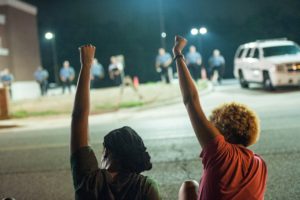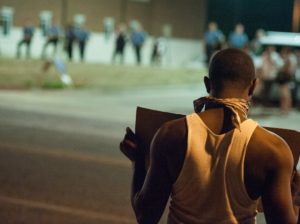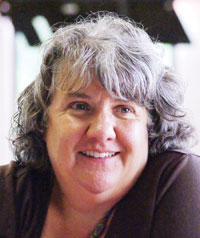 Pam Nath has been living and working in New Orleans, LA for the past seven years. She works for Mennonite Central Committee Central States and is a Roots of Justice trainer.
Pam Nath has been living and working in New Orleans, LA for the past seven years. She works for Mennonite Central Committee Central States and is a Roots of Justice trainer.
“The Spirit of the Lord is upon me, because he has annointed me to bring good news to the poor. He has sent me to proclaim release to the captives and recovery of sight to the blind, to let the oppressed go free, to proclaim the year of the Lord’s favor.” Luke 4:18-19
“…the hands of none of us are clean if we bend not our energies to righting these great wrongs.” W.E.B. DuBois
I traveled to Ferguson, Missouri from August 21-24 along with two other community organizers from New Orleans, La. We visited the Canfield Green apartments where 18-year-old Michael Brown was shot and killed by a police officer and where beautiful memorials had been created. One sign referenced the story of Cain and Abel in Genesis 4: 8-10 – “And the Lord says: ‘What have you done? The voice of your brother’s blood cries out.” And indeed, roses lined the street where traces of Michael’s blood were still evident, crying out for those with ears to hear. 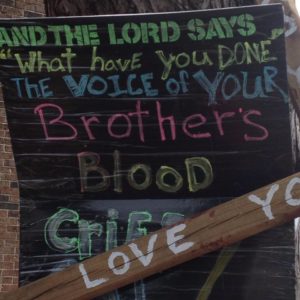
We talked with Ferguson residents, including a group camped out in a parking lot across from the police station and some youth camped in the “approved assembly area” in the parking lot of an old car dealership. Both of these groups said they planned to stay until Darren Wilson, the police officer who killed Michael Brown was indicted, and we brought them water and ice and fruit as a way of expressing our support and appreciation for their persistent call for justice.
That evening, we saw how West Florissant Avenue was closed to all through traffic, beginning at its intersection with Chambers Road, a full mile away from the “approved assembly area.” Anyone who wanted to join the protest had to walk a mile just to get to the protest site and then march in a spot cut off from the rest of the public, where police imposed a “5-second rule” which required protestors to keep moving, breaking up any conversations among groups of protestors who began to gather together.
This was only the most recent attempt to contain and squash people’s cries for justice. Others who had been in Ferguson earlier reported even more intense police repression. Police shot tear gas and rubber bullets at unarmed people who were in places they had every right to be including their own backyards, driveways and doorways. Purvi Shah of the Center for Constitutional Rights was part of a multigenerational crowd –including a number of children– into which police fired tear gas, with no warning and a full three hours before the midnight curfew that had recently been established. Many first person stories of encounters with police oppression are available if you look for them. What we saw in Ferguson was a community under occupation by police. No one felt safer. The constant threat of violence by police toward protestors was palpable.
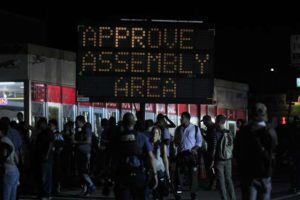 The power of the state arrayed against the people of Ferguson reminds me of Desmond Tutu’s quote about an elephant with its foot on the tail of a mouse. Reverend Tutu advised us: “If you are neutral in situations of injustice, you have chosen the side of the oppressor. If an elephant has its foot on the tail of a mouse, and you say that you are neutral, the mouse will not appreciate your neutrality.”
The power of the state arrayed against the people of Ferguson reminds me of Desmond Tutu’s quote about an elephant with its foot on the tail of a mouse. Reverend Tutu advised us: “If you are neutral in situations of injustice, you have chosen the side of the oppressor. If an elephant has its foot on the tail of a mouse, and you say that you are neutral, the mouse will not appreciate your neutrality.”
What is extraordinary about Ferguson is not the killing of an unarmed black youth or the ways that institutions like the police, city government, etc. act in racist ways. That happens in New Orleans and it happens across the country. What is special and inspiring about Ferguson is that people’s thirst for justice is so strong there that they persist in protests despite the ways they are persecuted and threatened by the powerful militarized forces arrayed against them. Like Jesus, they are guided not by what is, but by their vision of what can and should be, and because of this, they, like Jesus, have found the courage to speak out in defiance of the powers of Empire, even to the point of risking their lives. They have done this now for two weeks.
The evening of Friday, August 22, the 13th day after Michael was shot, we joined protestors who had left the approved assembly area and marched three miles to the Ferguson Police Department, to drums and chants of “We want justice,” “No Justice, No Peace!” and “Indict that cop.” Despite the fact that they were met at the police department by a line of armed police who stood in formation, blocking their access to the building, people gathered across the street and continued to cry out for justice through song, drumming and conversation. One young man said on the mic, “We are not going to go over there tonight. Let’s be clear that we have a right to go over there, but we are not going to exercise that right tonight.”
I am reminded of a powerful sermon response that Vincent Harding delivered at the Eighth Mennonite World Conference in Amsterdam in the summer of 1967:
The beggars are rising – they refuse to lie on the ground, crippled, crushed, begging. They are rising in Detroit and in Harlem…. and among them is Christ, the beggar of Nazareth. Do you see him? Do you hear him in the noise of all the voices? Do you realize how his spirit blasts all bastions of security, affluence, and greed? He is there. We can hide but he is there. We can continue paying our taxes for armies and bombs, and continue to cry: ‘What can we do?’ We can call on the police and the army. Fearfully we can hide behind law and order or behind the walls of our churches. Nevertheless, there is a spirit walking freely upon the earth. There is a spirit in search of freedom. This spirit will not perish…. We should know one thing – the insurrectionist beggars are not waiting any longer. Christ has promised to help all beggars and he keeps his promise. Let us not misunderstand. He is on the side of the beggars. On which side are we as Mennonites, Christians, and humans who love humanity? ….Are we surrounded by the barricades of a status quo where we pray that the storm may pass on so that we can continue living without disturbance? …. In this case, we must admit that we are…. missionaries of law and order, defenders of a status quo, and seekers for peace without a cross.
I saw good news in Ferguson. I encountered the Spirit of Truth and Love and Hope there. As someone who has committed my life to working against racism, sometimes I despair. The systems that we fight against are huge and trap us all, including white people, and it can be hard to believe that things can change. I have often clung to words like Arundhati Roy’s: “Another world is not only possible, she is on her way. On a quiet day, I can hear her breathing.” In Ferguson, I heard the whispers of a new world, stirrings of the promise of Hebrews 12:27, that things will be shaken up so that “what cannot be shaken may remain.”
The message of the Gospel is that there is a Force more powerful than Empire, more powerful than White Supremacy, and these protesters are preaching the Gospel! I saw in their faces not only righteous anger and determination, but also joy, because they have discovered that they are free because, like Jesus, they no longer are walking in the fear of death. In the face of that sort of Soul-Force, the power of empire fades into the background, like the police line in the beautiful pictures my friend Aziz took of the protesters while we were in Ferguson.
As people who believe in the gospel of peace, now is a time that presents an amazing opportunity for Mennonites to give flesh to our beliefs. Let’s not repeat the mistakes of the past when way too few Mennonites responded to Vincent Harding’s call to join in the civil rights movement. Let’s not repeat the mistakes of the Christians to whom Martin Luther King Jr wrote his Letter from Birmingham Jail:
I have almost reached the regrettable conclusion that the Negro’s great stumbling block in the stride toward freedom is not the White Citizens Councillor or the Ku Klux Klanner but the white moderate who is more devoted to order than to justice; who prefers a negative peace which is the absence of tension to a positive peace which is the presence of justice; who constantly says, ‘I agree with you in the goal you seek, but I can’t agree with your methods of direct action’; who paternalistically feels that he can set the timetable for another man’s freedom….Shallow understanding from people of good will is more frustrating than absolute misunderstanding from people of ill will. Lukewarm acceptance is much more bewildering than outright rejection.
In order to respond to the Gospel call for Justice coming out of Ferguson, we need to get clarity about what true peacemaking looks like. Peace is not refusing to be in open conflict or refusing to take sides in conflicts which exist. The situation in Ferguson doesn’t call for neutral mediators, bridge-builders between two sides who are in conflict, with us in the role of “peacemakers.” The “two sides” don’t have equal power, and they aren’t both right.
Like Desmond Tutu, historian and social justice worker Howard Zinn warned against neutrality in the face of oppressive power. In Declarations of Independence: Cross-Examining American Ideology (a helpful read for those who wish not to conform to the world but instead to be “transformed by the renewing of our minds” Romans 12:2), Zinn writes:
Why should we cherish “objectivity”, as if ideas were innocent, as if they don’t serve one interest or another? Surely, we want to be objective if that means telling the truth as we see it, not concealing information that may be embarrassing to our point of view. But we don’t want to be objective if it means pretending that ideas don’t play a part in the social struggles of our time, that we don’t take sides in those struggles. Indeed, it is impossible to be neutral. In a world already moving in certain directions, where wealth and power are already distributed in certain ways, neutrality means accepting the way things are now. It is a world of clashing interests – war against peace, nationalism against internationalism, equality against greed, and democracy against elitism – and it seems to me both impossible and undesirable to be neutral in those conflicts.
When we choose neutrality and are unwilling to engage conflict, we are clinging to the false peace that Martin Luther King, Jr. and the Old Testament prophets warned against.“They have treated the wound of my people carelessly,” Jeremiah warned, “saying ‘Peace, peace.’ when there is no peace (6:14).” We need to face the cracks in the very structure of our society, rather than just trying to cover up cracks in the walls, as Ezekiel warned: “…they have misled my people, saying, “Peace,” when there is no peace; and … when the people build a wall, these prophets smear whitewash on it (Ezekiel 13:10).”
What would working toward a positive peace in Ferguson look like? Chris Crass, a white antiracist organizer, gives us one vision:
So I’m seeing all these pictures from last night of adults trying to convince young Black people to leave the streets and only protest during the day in Ferguson, and this is being heralded by the police and mainstream media as “helping bring peace to Ferguson.” Where are the pictures of the white community leaders, the Federal government and the United Nations standing before the police in Ferguson telling them to put their guns down, go back to their homes, to take their frustrations out in constructive ways and to stop making us (the white community and the U.S. government) look like vicious, armed to the teeth, defenders of a white supremacist society without an ounce of regard for Black lives?
“Peace”, as defined by the state and mainstream media, in Ferguson, means a return to the, below the national radar, war against the Black community that is “normal life” in this town that the Mayor repeatedly affirms “has no racial conflict”. Conflict, we are to understand, only exists when oppressed people fight back, but when oppressors rule through racist laws, policies, culture, and violence, it’s “peace”. That is why ever since the Rodney King rebellion in Los Angeles in 1992, the slogan is “No Justice, No Peace”. The Black young people in Ferguson, bringing discipline, non-violence, and determination in the face of continued violence and media smearing, are heroes!
The positive peace that Jesus calls us to work toward requires the presence of justice. Here are just a few of my ideas about some ways to work for justice that holds the promise of real peace. I am excited to hear others’ ideas as well.
• We can support the demands of groups organizing on the ground in Ferguson through letters to the editor, letters to your governmental representatives, conversations with friends, family, church and community members
• Send money to support the organizing in Ferguson
• Join or organize a solidarity march
• Find out what is happening in your city/town to address racial inequities and support the work, particularly groups led by organizers of color
• Sign this Color of Change petition calling on GoFundMe to cancel the fundraising site for Darrin Wilson. Wilson is on paid leave and since he has not yet been charged, has no legal fees, yet donations to support him have exceeded donations to the Brown family.
• Check out other suggestions for action in this toolkit put out by Showing Up for Racial Justice, a network of white antiracist organizers
Let us not repeat the mistakes of our past. Let us join in this movement for change, this movement for justice, this movement for real peace, this movement where we will experience Jesus walking next to us and the Truth shall set us Free.
Additional Recommended Readings
- “Black Bodies, White Souls,” by Austin Channing
- “The Cross and the Molotov Cocktail,” by Christena Cleveland
- “White Privilege: An Insidious Virtue that’s Eating America from Within,” by Andrew O’Hehir
- The New Jim Crow: Mass Incarceration in the Age of Colorblindness, by Michelle Alexander
- Read more about the context in which Michael Brown’s shooting occurred: A black person is killed by police or security officers or self appointed vigilantes every 28 hours in this country. Before Michael Brown, it was Eric Garner and John Crawford, and after, it was Ezell Ford, Dante Parker,and Kajieme Powell. Black women are also victims of police killing, such as the case of Tarika Wilson, who was shot and killed because the officer said the baby she was holding in her arms looked like a gun. Over time, the names of the dead have accumulated. Many names are only known locally such as Keith Atkinson and Justin Sipp, both from New Orleans. And no official records are kept so every 28 hours is likely an underestimate of the frequency with which people are killed. It is rare for officers to be convicted in these shootings, and when they are, such as in the case of 20-year-old Wendell Allen in New Orleans, the relatively short sentences also send a message that black life is devalued.
- Read about ways that “the elephant’s tail-stepping” occurs in other systems besides criminal justice: Ta-Nehisi Coates recently published an important review of racist housing policy and the case for reparations. Voter suppression, school closures in African American communities, and persistent racial disparities in unemployment rates are just some of the ways that the systems and institutions in this country provide unequal access and privileges to white people at the expense of people of color.


